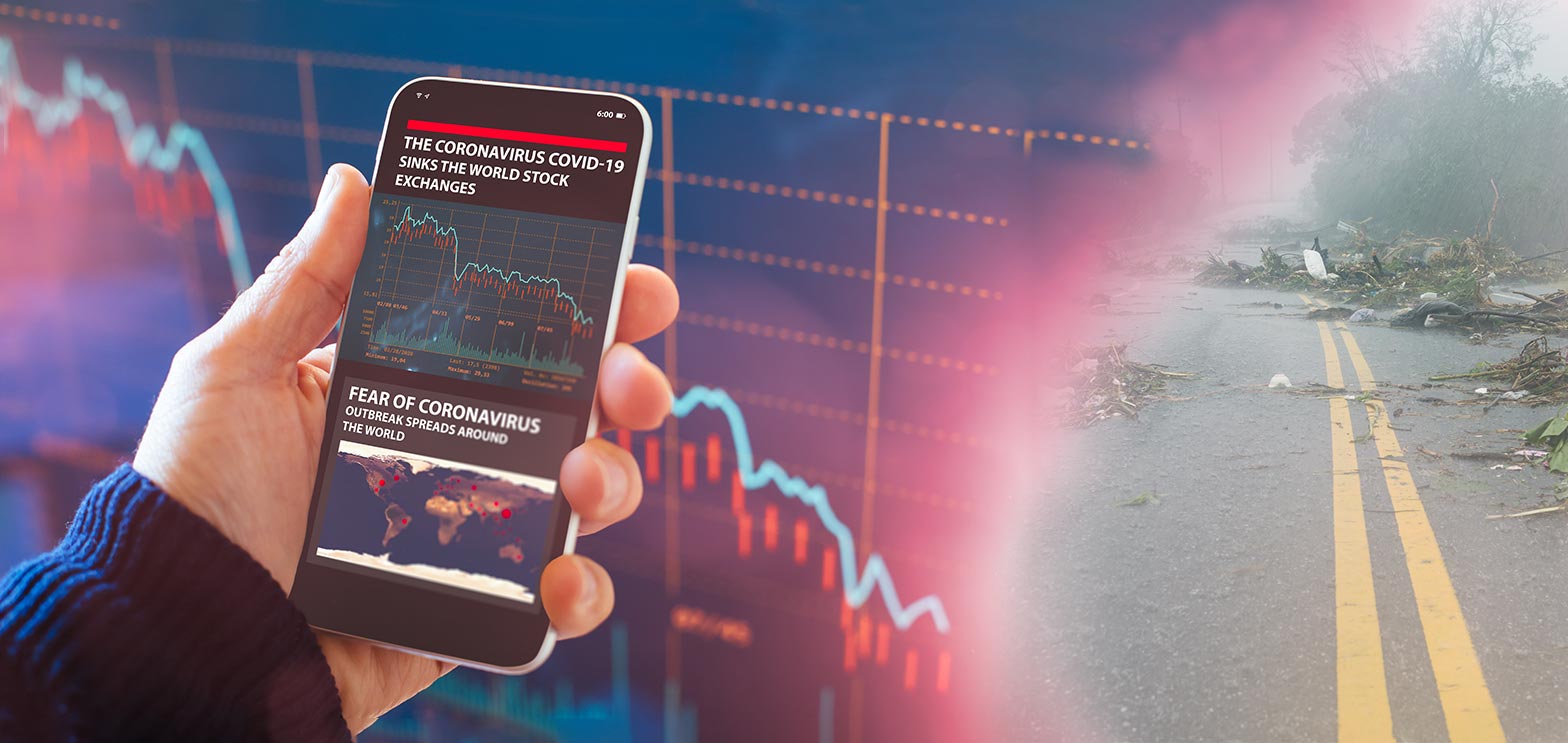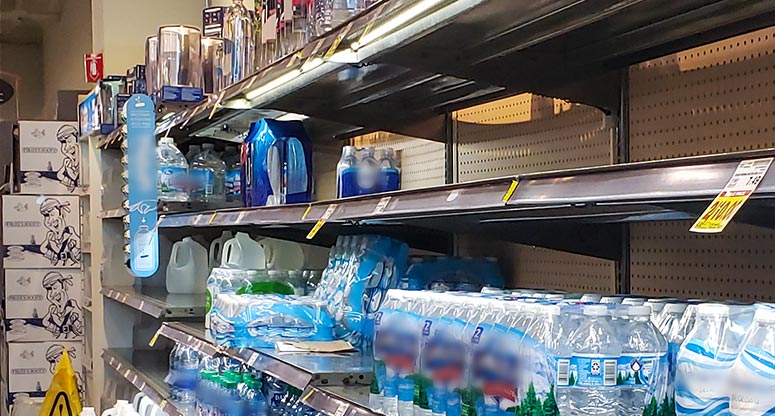Operations5.5-minute read
Tips for Tackling COVID-19
The COVID-19 pandemic is a once in-a-century phenomenon, comparable to nothing else we’ve faced in the modern era. It’s a crisis that’s already shut down a wide section of daily life and economic activity, from travel and sports to global finance and healthcare.

How long will it all last? How will it end? Will we be able to recover? Billion-dollar questions all, and ones that are impossible to answer with any level of certainty.
Yet, there is a way ahead. Thanks to efforts to mitigate the effects of mega-disasters—such as hurricanes and wildfires—disaster recovery has become a sophisticated and effective resource over the past several decades. And COVID-19, say some experts, can be mitigated by applying those resources on a larger scale and timeline.
COVID-19: ‘A Slow-Motion Hurricane’
“The coronavirus has been called, with some justification, a ‘slow-motion hurricane,’” writes Adam Sobel for The New York Times, in a piece examining how lessons learned from hurricane response can apply to pandemic recovery.

The lessons learned from hurricane recovery strategies can help guide us toward a plan for pandemic disaster recovery.
Source: www.shutterstock.com.
Author: ezellhphotography.
An atmospheric scientist at Columbia University, he draws a direct connection between hurricane disaster efforts that have been become so effective in recent decades, to the need to treat the challenges of the new COVID-19 pandemic as disaster recovery writ large.
Even better, the lessons learned from hurricane recovery strategies can help guide us toward a plan for pandemic disaster recovery—and it’s not too late to puts those lessons into action.
“Our response to powerful storms in recent years has improved dramatically,” Sobel notes. An analysis of those responses reveals “common elements that can guide our response to the current crisis.”
For our part, we’ve been addressing those “common elements” for decades. Our experts have long been applying the benefits of the virtual workforce and on-demand customer service to business recovery plans that can help ensure continuous service during times of emergency or widespread outages. And they have some tips on how to get the job done.
Checklist: 7 Essential Steps for Your Pandemic Disaster Recovery Plan
1. Appoint a dedicated recovery leader. In addition to uncertainty, disorganization is at the heart of much of the current chaos. From shared goals to acceptable timeframes, the lack of agreement and coordination across departments—or state lines—makes finding solutions all the more difficult.

Appoint a dedicated recovery leader to head up the recovery process and implementation during the crisis.
Source: www.shutterstock.com.
Author: Olena Yakobchuk.
Appointing a prominent manager or member of executive team to head up the process of recovery planning and implementation is the first step toward making recovery a central goal of your organization. And because it gives a dedicated party some measure of executive authority, as well as personnel to carry out his or her wishes, it’s also likely the most important.
2. Organize a strategy. The first objective for your new leader is carve out a cross-department plan for isolating essential functions. Learn what can and should be temporarily shut off to keep the ship afloat for as long as possible, and what the deadlines are for doing so.

Learn what can and should be temporarily shut off to keep the ship afloat for as long as possible.
Source: www.shutterstock.com.
Author: Dmytro Tyshchenko.
Remember, some customers will expect business as usual. And if you’re not largely affected, but your customers are, you may still be facing payment defaults and cancelled orders. So make sure your strategy includes demographic considerations, and a back-up plan to achieve continuous customer communications should the need arise to put your on-site efforts on hold.
3. Plan for the long term. In the southeastern U.S., the late summer and autumn months are endured in a state of high alert. At any moment, the abrupt appearance of a threatening storm can lead to widespread evacuations and destruction. And it can all happen over just a few days.

A comprehensive pandemic disaster recovery plan needs to make use of every spare moment to build resiliency for difficult times.
Source: www.shutterstock.com.
Author: Rido.
Despite this six-month window, businesses that perform better with hurricane recovery know that every month is equally important to their overall plans. Like a workable hurricane strategy that spans the entire year, a comprehensive pandemic disaster recovery plan needs to make use of every spare moment to build resiliency for difficult times.
4. Focus on team and community. Effective preparedness means considering and accommodating the difficulties your workers, customers and immediate community members are likely to face either, directly or indirectly. A focus on creating a community that’s at least partially virtual can help sustain your culture when shared physical space is temporarily cut off.
5. Secure your remote work infrastructure. As we’ve seen, the shutdown of economic activity and social distancing measures caused by virus-prevention strategy have generated a new urgency for almost complete remote work, in as many sectors of the economy as can accommodate it.

Many companies have developed a proven process and security system for enabling their team members to work off-site.
Source: www.shutterstock.com.
Author: Gorodenkoff.
For many companies, remote work is nothing new. They’ve long ago developed a proven process and security system for enabling their team members to work off-site. Many others, though, are just now creating remote office networks. For them, the greatest challenge may be ensuring security at every level, to protect not just themselves and their workers but their clients, too.
That includes creating a business VPN, erecting firewalls, generating backups, monitoring network vulnerabilities, verifying agent backgrounds, implementing authentication protection, conducting third-party compliance audits and more. As with any part of your business, ensuring the security of your remote-work network is a full-time job requiring real expertise.
6. Get access to an emergency network for IT, communications and labor. A central aspect of effective disaster recovery is the dispersal of key points within your operational network across to diverse geographic areas. From contact center workers who work remotely to out-of-state data centers, network dispersal helps ensure continuous operations during time of local difficulty.
7. Improve flexibility and scalability with the use of analytics. Making a slightly greater effort to track and analyze the data generated by your various customer and client touchpoints pays huge dividends in the long run. In general, more specific knowledge about where and how people shop empowers you to offer more of what they like, and less of what they don’t.

Making a slightly greater effort to track and analyze the data generated by your various customer and client touchpoints pays huge dividends in the long run.
Source: www.shutterstock.com.
Author: Gorodenkoff.
For disaster planning, the applied use of this data can help chart a variety of possible scenarios, and then plan accordingly. As with the “what if” system used in hurricane disaster modeling, this expands the ability to respond quickly to a huge variety of situations.
Knowledge, indeed, is power. And engaging with analytics (on an ASAP priority) doesn’t just improve your odds of weathering the current storm. It also helps you fine-tune certain operational and organizational strategies. The result? When we finally exit the lockdown phase and enter recovery, you’ll have added reserves of built-in flexibility and scalability.
It’s Not Too Late to Create Your Pandemic Disaster Recovery Plan
The economic ruin caused by an increasing number of Americans being forced to stay home—and many of those losing their jobs—isn’t dissimilar to a large-scale, national-level hurricane. Both are prolonged disasters that affect millions and cost billions. They present difficult choices between society and the individual, health and prosperity, risk and lockdown, life and death.
At Working Solutions, planning to and responding to challenges like this are central to what we do. Since the 1990s, our on-demand contact center services have helped organizations of all sizes stay open for business while dealing with disasters like hurricanes Sandy, Matthew and Harvey.
Taken together, our suite of business process outsourcing (BPO) offerings—including customer care, sales and tech support—can help you chart a pandemic disaster recovery plan based on real-world experience. With an on-demand workforce that spans the U.S. and Canada, we have the experts and resources to help you get through the current crisis and prosper on the other side.

Learn more about how we can help. Contact us today to consult one of our experts.
We can help.
This Might Interest You...
This website uses cookies to personalize and improve your experience. Continue browsing our site if you agree to our Cookie Policy or feel free to Manage Cookies yourself.


